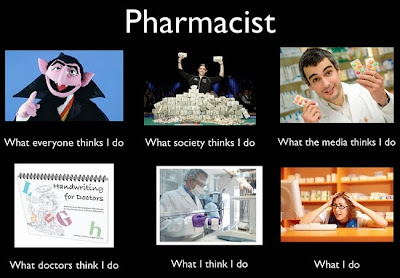 |
| What do you think about yourself? |
Tuesday, November 19, 2013
Thursday, November 7, 2013
How Do Drugs Work?
The site of action of a drug is the location in the body where the drug performs its desired function. For example, a drug may act in the brain, heart, eye, or kidney. Within the organ, the drug may act on a particular component of the organ, such as a certain type of cell. Drug action may be extracellular, where the drug performs its function outside the cell, or intracellular, in which case the drug has to enter the cell to work. Alternatively, the action may be on the cell surface, at the cell membrane.
Drugs work by interacting with target molecules found at the site of action, and altering their activity in a way that is beneficial to health. Drug targets are usually biomolecules such as proteins, protein complexes, or nucleic acids that play a role in a particular disease process. In most cases, the drug must temporarily attach bind) to the target to exert its action. The drug–target binding can either stimulate the target or block the normal activity of the target, resulting in a physiological effect. A common type of drug target is a receptor, generally a protein on the cell membrane, that can bind with a specific molecule (such as an endogenous compound or a drug) to alter the cell’s behavior. The interactions between a drug and its receptor and succeeding events that lead to pharmacological action of the drug are broadly considered the field of pharmacodynamics.
A simple analogy often used to describe drug–target interactions is that of a lock and key—the target is a lock on a door that only a certain drug (the key) can bind to and open, this is illustrated in Figure 1.1. Ideally, the key should not fit any other lock, and different keys should not open this lock. Some keys may fit in the lock, but not perfectly. Consequently, these imperfect keys cannot open the door. Yet, by fitting into the lock, imperfect keys prevent the original key from fitting into the lock; they therefore block the door from opening.
In reality, most targets are not as rigid as locks and the active site can somewhat change its shape and size depending on the environment. Most drugs, also, are not as specific as a key. Thus target–drug interactions are much more complex than the simple lock-and-key analogy leads us to believe. Few drugs interact exclusively with their intended target. Many drugs bind to more than one type of target and influence physiological or biochemical processes that were not targeted. This leads to undesirable side effects of drugs, or toxicity. [Source: Pharmaceutical Sciences Book Chapter]
Drugs work by interacting with target molecules found at the site of action, and altering their activity in a way that is beneficial to health. Drug targets are usually biomolecules such as proteins, protein complexes, or nucleic acids that play a role in a particular disease process. In most cases, the drug must temporarily attach bind) to the target to exert its action. The drug–target binding can either stimulate the target or block the normal activity of the target, resulting in a physiological effect. A common type of drug target is a receptor, generally a protein on the cell membrane, that can bind with a specific molecule (such as an endogenous compound or a drug) to alter the cell’s behavior. The interactions between a drug and its receptor and succeeding events that lead to pharmacological action of the drug are broadly considered the field of pharmacodynamics.
A simple analogy often used to describe drug–target interactions is that of a lock and key—the target is a lock on a door that only a certain drug (the key) can bind to and open, this is illustrated in Figure 1.1. Ideally, the key should not fit any other lock, and different keys should not open this lock. Some keys may fit in the lock, but not perfectly. Consequently, these imperfect keys cannot open the door. Yet, by fitting into the lock, imperfect keys prevent the original key from fitting into the lock; they therefore block the door from opening.
In reality, most targets are not as rigid as locks and the active site can somewhat change its shape and size depending on the environment. Most drugs, also, are not as specific as a key. Thus target–drug interactions are much more complex than the simple lock-and-key analogy leads us to believe. Few drugs interact exclusively with their intended target. Many drugs bind to more than one type of target and influence physiological or biochemical processes that were not targeted. This leads to undesirable side effects of drugs, or toxicity. [Source: Pharmaceutical Sciences Book Chapter]
Subscribe to:
Comments (Atom)
